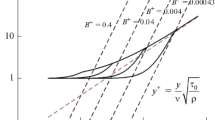Abstract
The dissipation theorem does a respectable job of describing turbulent mass transfer in the rotating-cylinder system, although parameters still need to be obtained by fitting against experimental data. Unfortunately the available experimental data show discrepancies that hamper theoretical development. This is part of a long-range program to compare the predictions of the dissipation theorem to systems ranging from pipe flow and rotating cylinders to developing flows on a rotating disk and on a flat plate at zero incidence, where extensive experimental data exist. One learns that values of the eddy viscosity should superpose after dividing by the stress parameter R+ in order to obtain coherent behavior at very large Reynolds numbers. One innovation here is to use the mass-transfer data as a proxy for the absence of torque data. One finds that the data of Eisenberg and of Mohr do not constitute a single coherent data set even though they were obtained on the same apparatus and with the same chemical system. New experimental data are needed to resolve these discrepancies. The dissipation theorem is supposed to enhance our understanding of turbulence and permit prediction of the behavior of turbulence in a variety of systems. The next step is to apply it to developing flows on a flat plate and a rotating disk.
Similar content being viewed by others
References
Newman, J., Theoretical analysis of turbulent mass transfer with rotating cylinders, J. Electrochem. Soc., 2016, vol. 163, pp. E191–E198.
Newman, J., Application of the dissipation theorem to turbulent flow and mass transfer in a pipe, Russ. J. Electrochem., 2017, vol. 53, pp. 1061–1075.
Newman, J., Further thoughts on turbulent flow in a pipe, Russ. J. Electrochem., 2019, vol. 55, pp. 34–43.
Theodorsen, T. and Regier, A., Experiments on drag of revolving disks, cylinders, and streamline rods at high speeds, Report of National Advisory Committee for Aeronautics, 1944, no. 793.
Nikuradse, J. Gesetzmässigkeitem der turbulentem Strömung in glaten Rohren, Forschungsheft 356, Beilage zu Forschung auf dem Gebiete des Ingenieurwesens, Edition B, Volume 3, September/October, 1932 (Berlin NW7:VDI-Verlag GMBH, 1932). Translated as Nikuradse J., Laws of turbulent flow in smooth pipes, NASA TT F-10, 359, Washington: National Aeronautics and Space Administration, Oct. 1966.
Gorland, S.H., Kempke, E.E., Jr., and Lurnannick, S., Experimental windage losses for close clearance rotating cylinders in the turbulent flow regime, NASA Technical Memorandum, Cleveland, OH: Lewis Research Center, June 1970, no. NASA TM X-52851.
Author information
Authors and Affiliations
Corresponding author
Additional information
Published in Russian in Elektrokhimiya, 2019, Vol. 55, No. 1, pp. 51–59.
The article is published in the original.
Rights and permissions
About this article
Cite this article
Newman, J. Turbulent Flow with the Inner Cylinder Rotating. Russ J Electrochem 55, 44–51 (2019). https://doi.org/10.1134/S1023193519010117
Received:
Revised:
Accepted:
Published:
Issue Date:
DOI: https://doi.org/10.1134/S1023193519010117




